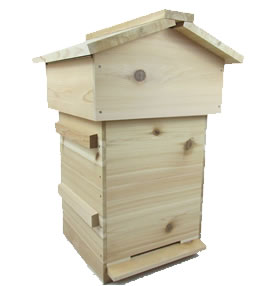Langstroth Hive: Understanding the Beekeeper's Essential Tool
The Langstroth hive is a cornerstone of modern beekeeping, revolutionizing the way beekeepers manage and harvest honeybee colonies. Invented by Reverend Lorenzo Lorraine Langstroth in the mid-19th century, this hive design introduced several innovative features that have since become standard in beekeeping practices worldwide.
Key Features of the Langstroth Hive
The Langstroth hive is characterized by its modular, vertically stacked design, consisting of individual boxes, frames, and removable components. The key features of the Langstroth hive include:
- Standardized Frame Dimensions: Langstroth introduced the concept of standardized frame dimensions, with frames fitting snugly within the hive boxes. This design allows for easy inspection, manipulation, and interchangeability of frames between hives.
- Vertical Stacking: The Langstroth hive is designed to be stacked vertically, with multiple boxes placed on top of each other. This vertical arrangement provides ample space for bee colony expansion and honey storage, while also facilitating efficient management and harvesting.
- Removable Frames: One of the most significant innovations of the Langstroth hive is the use of removable frames. These frames, typically fitted with wax foundation or comb guides, allow beekeepers to inspect the hive, monitor colony health, and extract honey without disturbing the bees excessively.
- Bottom Board and Cover: The Langstroth hive features a bottom board to provide a stable base and an outer cover to protect the hive from the elements. These components contribute to the hive's durability, insulation, and overall functionality.
Benefits of the Langstroth Hive
The Langstroth hive offers several advantages for both beekeepers and honeybee colonies:
- Improved Hive Management: The modular design and removable frames of the Langstroth hive make hive management tasks such as hive inspections, pest control, and disease management more accessible and less disruptive to the bees.
- Maximized Honey Production: The Langstroth hive's vertical stacking design provides ample space for honey storage, allowing beekeepers to maximize honey production per hive.
- Enhanced Bee Health: By providing a stable and well-ventilated environment, the Langstroth hive promotes optimal bee colony health and productivity, leading to stronger, more resilient bee populations.
- Scalability: Beekeepers can easily expand or reduce the size of Langstroth hives by adding or removing boxes as needed, making them adaptable to the changing needs of bee colonies.
Conclusion
The Langstroth hive remains a fundamental tool in modern beekeeping, embodying principles of efficiency, practicality, and sustainability. Its innovative design has revolutionized beekeeping practices, allowing beekeepers to manage honeybee colonies more effectively while promoting bee health and honey production.
Whether used by hobbyists, small-scale beekeepers, or commercial operations, the Langstroth hive continues to play a vital role in supporting honeybee populations and sustaining the art and science of beekeeping for generations to come.
Simple device and extraction steps
1. Put 2/3 volume of water in the aluminum pot and boil it. Tie the bag with beeswax raw material tightly with cotton thread, tie a slip knot, place it in water, and then boil the water.
2. Place the large bathtub diagonally and pour some cold water into it, so that half of the bottom area of the basin is submerged in the water and half is exposed to the surface of the water, that is, the bottom of the basin is half wet and half dry.
3. Lift the freshly boiled bag containing beeswax with an iron clip, place it in a dry place above the bottom of the bathtub, press hard with a pressure plate to press out the wax inside, and let it flow into the water below the bottom of the basin . After cooling, remove and place in a medium water basin.
4. Put the wax bag that has not been squeezed completely back into the aluminum pot and continue heating. After the water boils, take out the wax bag with an iron clip, squeeze and extract the beeswax in the same way.
5. In this way, after a bag of wax is repeatedly burned, squeezed, and taken three times, open the bag and discard the wax residue. Then put a bag of beeswax raw materials, use the same method three times to burn, squeeze, and take the beeswax.
6. Pour out the sewage in the aluminum pot, wash it, and replace it with clean water.
7. Pour the beeswax extracted just now and put it in a medium-sized water basin, put it in an aluminum pot, cover the pot, and slowly bring it to a boil. Because beeswax is a flammable substance, it cannot be burned with an open flame, otherwise it will easily catch fire and cause waste and danger.
8. After it is boiled, in order to make the purified beeswax beautiful and good for sale, use a spoon to remove the bubbles that float on the surface of the wax in the pot. Take it out after it cools, and it becomes pure beeswax.



